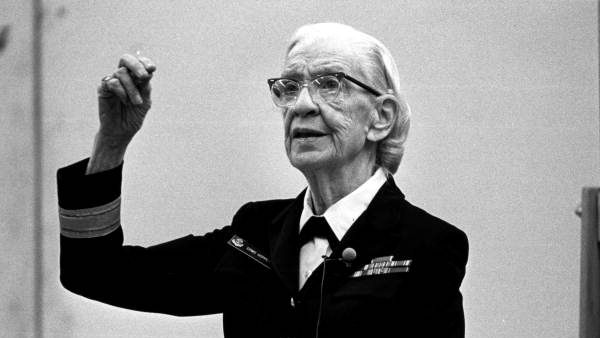Admiral Grace Murray Hopper
This brilliant woman was the “Jane of all trades”. She was born in 1906 in the States. Her fields of study were mathematics and computer science, however, she was one of the first three programming pioneers as well. To top it off she was also a social scientist, corporate politician, marketing whiz, systems designer and programmer. One of the reasons why she was able to achieve so much was because she believed that if she had done one thing once, there was no point in doing it again. She earned her Masters and PhD from Yale in 1930 and 1934 respectively, and then joined the US Navy, and after many years of service became Admiral. She came from a military family, and it came naturally to her. She joined the Navy WAVES (Women Accepted for Voluntary Emergency Service).
She worked with Howard H. Aiken on the electromechanical computer funded by the United States Navy. This was known as the Harvard Mark II, and she even co-authored two papers on this project. During her service she invented the compiler, which helped bridge communications between human and computer. She is quoted to have said:
“There sat that beautiful big machine whose sole job was to copy things and do addition. Why not make the computer do it? That’s why I sat down and wrote the first compiler. It was very stupid. What I did was watch myself put together a program and make the computer do what I did.”
She believed that we could communicate with machines, in human language. Her aim was to translate English instructions into the language understood by the intended computer. This made way for one of the first computer languages in English, COBOL, and she is mostly accredited for this. She had many ideas about computers, and what they could do, however she once said:
“We’re flooding people with information. We need to feed it through a processor. A human must turn information into intelligence or knowledge. We’ve tended to forget that no computer will ever ask a new question.
Even during that time, there was a lot of reliance on computers, however, AI was not as prevalent as it is today, and people could still control computers.
In 1949, she began working for the Eckert-Mauchly Computer Corporation, and aided in the development of the UNIVAC I computer. In 1954, Eckert-Mauchly elected Hopper to direct and manage their Department for Automatic Programming. 1n 1966, she took retirement from the Navy Reserve. A year later she was called in for active service by the United States Navy. After her official retirement from the Navy, she worked as a consultant for Digital Equipment Corporation.
Other attributions to her name include the USS Hopper (a guided missile destroyer), Cray XE6 “Hopper” (which is the supercomputer at NERSC). Forty honorary degrees were awarded to her during her lifetime, from universities across the globe. One of the colleges of Yale University was renamed in her honor. In 1991, she obtained the National Medal of Technology. On November 22, 2016, President Barack Obama posthumously awarded her the Presidential Medal of Freedom.
This year on October 1st, Grace Hopper Celebration will take place, which is the largest consortium of women technologists from all over the world. Produced by AnitaB.org, in partnership with ACM, the Grace Hopper Celebration will go on till the fourth of October, in Orlando, Florida.
When she retired from the Navy at the age of 79, she was the oldest officer to have been serving at the time. She died on 1st January 1992.












